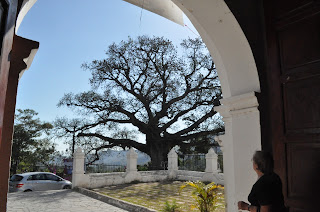Previous Sundays have consisted of attending Catholic mass, weekend trips to the beach or country, or visiting family. Today though, we did something old, something we used to do when I was but a wee chipilín, munching happily on raw sugar cane.
We went to the market. Grandma had a hankering for a bowl full of chilate, a rather tasteless broth or atol, served with a side of sweet syrupy buñuelos or nuegados. Previous experience had taught me I was not the biggest fan of this afternoon snack. But in the food's defense, I had based my harsh judgement on samples provided to me by Mister Donuts - if you have never heard of Mister Donuts click here, but it is basically an antique American fast breakfast food franchise from the 50s that has remained popular in El Salvador. How wrong was I to dismiss this local dish based on Mister Donuts' cold, bland and chunky interpretation.
So what is chilate? It is a water-based broth made out of toasted maize flour, whole peppercorns and ginger, thickened slightly with corn starch. In Mexico, it is very common to add chili and cocoa beans which is where the name comes from, but in El Salvador, the broth is not condimented too heavily so as to better compliment the side of buñuelos and/or nuegados. To me, a bowl of chilate is nothing without its sweet syrupy counterparts and vice versa. The term nuegados means nuggets and refers to sugared plantain or sweet potato chunks. Sugared pumpkin on the other hand is prepared with cinamon and brown sugar loaf and is called ayote. If you go to one of the popular food chains which sell local food (e.g. Mister Donuts or Typicos de Margoth) buñuelos are large male fist-sized profiteroles, deep fried and covered in sugar and brown sugar loaf syrup. They are made out of egg and wheat flour, usually slightly hard and stale and far too big and sweet to be consumed by one person. You are better off visiting a local market, or keeping an eye out for street vendors pushing around their chilate cart between 3-4 in the afternoon. Their approach is often marked by the echoing sounds of "chiilaaaaaaaate...."
Today, in a market close to Santa Tecla, the chilate lady had plenty of options on offer. The drink itself is always the same, served piping hot in a gourd with the occasional floating peppercorn. The sides are a different matter with various choices crispy yet chewy egg or yucca buñuelos, and flavorsome plantain, sweet potato or pumpkin nuegados. I had a serving of nugget sized yucca buñuelos and ayote candy with syrup, the perfect contrast to the peppery broth on a cool afternoon.
We went to the market. Grandma had a hankering for a bowl full of chilate, a rather tasteless broth or atol, served with a side of sweet syrupy buñuelos or nuegados. Previous experience had taught me I was not the biggest fan of this afternoon snack. But in the food's defense, I had based my harsh judgement on samples provided to me by Mister Donuts - if you have never heard of Mister Donuts click here, but it is basically an antique American fast breakfast food franchise from the 50s that has remained popular in El Salvador. How wrong was I to dismiss this local dish based on Mister Donuts' cold, bland and chunky interpretation.
So what is chilate? It is a water-based broth made out of toasted maize flour, whole peppercorns and ginger, thickened slightly with corn starch. In Mexico, it is very common to add chili and cocoa beans which is where the name comes from, but in El Salvador, the broth is not condimented too heavily so as to better compliment the side of buñuelos and/or nuegados. To me, a bowl of chilate is nothing without its sweet syrupy counterparts and vice versa. The term nuegados means nuggets and refers to sugared plantain or sweet potato chunks. Sugared pumpkin on the other hand is prepared with cinamon and brown sugar loaf and is called ayote. If you go to one of the popular food chains which sell local food (e.g. Mister Donuts or Typicos de Margoth) buñuelos are large male fist-sized profiteroles, deep fried and covered in sugar and brown sugar loaf syrup. They are made out of egg and wheat flour, usually slightly hard and stale and far too big and sweet to be consumed by one person. You are better off visiting a local market, or keeping an eye out for street vendors pushing around their chilate cart between 3-4 in the afternoon. Their approach is often marked by the echoing sounds of "chiilaaaaaaaate...."
Today, in a market close to Santa Tecla, the chilate lady had plenty of options on offer. The drink itself is always the same, served piping hot in a gourd with the occasional floating peppercorn. The sides are a different matter with various choices crispy yet chewy egg or yucca buñuelos, and flavorsome plantain, sweet potato or pumpkin nuegados. I had a serving of nugget sized yucca buñuelos and ayote candy with syrup, the perfect contrast to the peppery broth on a cool afternoon.














